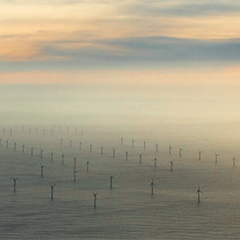Offshore wind market is reliant on key global markets
The offshore wind power industry continues to grow at a steady pace. It is expanding to new markets as cost reductions in the technology and demand for renewable energy become increasingly attractive to governments, power utilities, and other stakeholders. While the onshore wind market is larger in terms of total megawatt plant capacity added annually, offshore wind is growing quicker and offers a unique value proposition.
It is an abundant clean energy solution for many coastal load centers where a greater proportion of population and energy demand is located—often areas where the onshore wind resource is more difficult to develop. Other key factors for offshore wind project development include higher wind speeds, higher plant load factors, more stable power generation, and rapidly declining costs.
This article provides forecasts and insights into the offshore market through 2027. As of mid-2019, Navigant Research estimates there to be over 14.9 GW of offshore wind capacity in various stages of construction globally. This includes over 6 GW in China where, after years of delay, the offshore sector is reaching the massive scale expected of this market. The UK also has a large amount of capacity, with 4.8 GW in various stages of construction. The Netherlands follows with 1,483 MW, Germany with 1,080 MW, Denmark with 1,011 MW, Belgium with 370 MW, Taiwan with 120 MW, and South Korea with 60 MW. Globally, over 30.3 GW are in advanced planning stages, and these are projects considered highly probable to reach final investment decision and be built by 2028.
Policy Support Still a Key Driver for Offshore Growth
Unlike onshore wind, which has made inroads into many countries, the higher cost, risk, and complexity of offshore wind dictates that its markets are driven predominantly by countries that enact specific policy and regulatory drivers for wind. This narrows the current market for offshore wind to under a dozen countries. Among these are the UK, Germany, the Netherlands, Denmark, France, Belgium, and China. These countries are augmented by minor capacity in some select countries where development ambitions are being matched with supportive policy and development. These countries include Taiwan and the US, which are both on the cusp of a large takeoff.



























